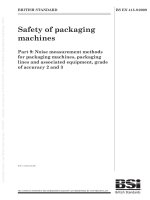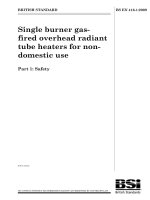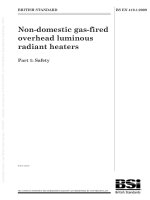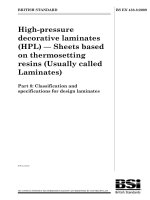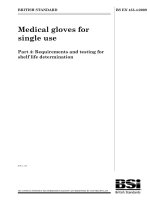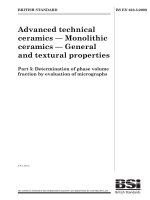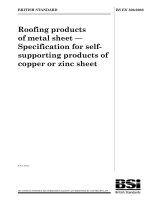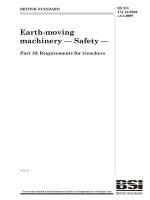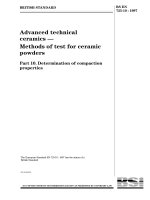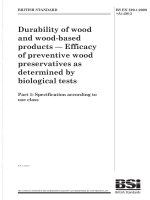Bsi bs en 61987 10 2009
Bạn đang xem bản rút gọn của tài liệu. Xem và tải ngay bản đầy đủ của tài liệu tại đây (1.73 MB, 54 trang )
Licensed Copy: athen reading, Reading University Library, 24/01/2010 10:29, Uncontrolled Copy, (c) BSI
BS EN 61987-10:2009
BSI Standards Publication
Industrial-process measurement
and control — Data structures
and elements in process
equipment catalogues —
Part 10: Lists of properties (LOPs) for industrial-process
measurement and control for electronic data
exchange — Fundamentals
NO COPYING WITHOUT BSI PERMISSION EXCEPT AS PERMITTED BY COPYRIGHT LAW
raising standards worldwide™
BRITISH STANDARD
Licensed Copy: athen reading, Reading University Library, 24/01/2010 10:29, Uncontrolled Copy, (c) BSI
BS EN 61987-10:2009
National foreword
This British Standard is the UK implementation of EN 61987-10:2009. It is
identical to IEC 61987-10:2009.
The UK participation in its preparation was entrusted to Technical Committee
AMT/7, Industrial communications: process measurement and control,
including fieldbus.
A list of organizations represented on this committee can be obtained on
request to its secretary.
This publication does not purport to include all the necessary provisions of a
contract. Users are responsible for its correct application.
© BSI 2010
ISBN 978 0 580 63449 9
ICS 25.040.40; 35.100.20; 35.240.50
Compliance with a British Standard cannot confer immunity from
legal obligations.
This British Standard was published under the authority of the Standards
Policy and Strategy Committee on 31 January 2010
Amendments issued since publication
Amd. No.
Date
标准分享网 www.bzfxw.com 免费下载
Text affected
Licensed Copy: athen reading, Reading University Library, 24/01/2010 10:29, Uncontrolled Copy, (c) BSI
BS EN 61987-10:2009
EUROPEAN STANDARD
EN 61987-10
NORME EUROPÉENNE
September 2009
EUROPÄISCHE NORM
ICS 25.050.40; 35.100.20
English version
Industrial-process measurement and control Data structures and elements in process equipment catalogues Part 10: Lists of properties (LOPs) for industrial-process measurement
and control for electronic data exchange Fundamentals
(IEC 61987-10:2009)
Mesure et commande
dans les processus industriels Structures et éléments de données
dans les catalogues d'équipement
de processus Partie 10: Liste des propriétés (LOPs)
pour les mesures et commandes
dans les processus industriels
pour les échanges électroniques
de données Fondamentaux
(CEI 61987-10:2009)
Industrielle Leittechnik Datenstrukturen und -elemente
in Katalogen der Prozessleittechnik Teil 10: Merkmalleisten (ML)
für den elektronischen Datenaustausch Grundlagen
(IEC 61987-10:2009)
www.bzfxw.com
This European Standard was approved by CENELEC on 2009-08-01. CENELEC members are bound to comply
with the CEN/CENELEC Internal Regulations which stipulate the conditions for giving this European Standard
the status of a national standard without any alteration.
Up-to-date lists and bibliographical references concerning such national standards may be obtained on
application to the Central Secretariat or to any CENELEC member.
This European Standard exists in three official versions (English, French, German). A version in any other
language made by translation under the responsibility of a CENELEC member into its own language and notified
to the Central Secretariat has the same status as the official versions.
CENELEC members are the national electrotechnical committees of Austria, Belgium, Bulgaria, Cyprus, the
Czech Republic, Denmark, Estonia, Finland, France, Germany, Greece, Hungary, Iceland, Ireland, Italy, Latvia,
Lithuania, Luxembourg, Malta, the Netherlands, Norway, Poland, Portugal, Romania, Slovakia, Slovenia, Spain,
Sweden, Switzerland and the United Kingdom.
CENELEC
European Committee for Electrotechnical Standardization
Comité Européen de Normalisation Electrotechnique
Europäisches Komitee für Elektrotechnische Normung
Central Secretariat: Avenue Marnix 17, B - 1000 Brussels
© 2009 CENELEC -
All rights of exploitation in any form and by any means reserved worldwide for CENELEC members.
Ref. No. EN 61987-10:2009 E
Licensed Copy: athen reading, Reading University Library, 24/01/2010 10:29, Uncontrolled Copy, (c) BSI
BS EN 61987-10:2009
EN 61987-10:2009
-2-
Foreword
The text of document 65E/134/FDIS, future edition 1 of IEC 61987-10, prepared by SC 65E, Devices and
integration in enterprise systems, of IEC TC 65, Industrial-process measurement, control and automation,
was submitted to the IEC-CENELEC parallel vote and was approved by CENELEC as EN 61987-10 on
2009-08-01.
This part of EN 61987 has to be read in conjunction with EN 61987-1.
The following dates were fixed:
– latest date by which the EN has to be implemented
at national level by publication of an identical
national standard or by endorsement
(dop)
2010-05-01
– latest date by which the national standards conflicting
with the EN have to be withdrawn
(dow)
2012-08-01
Annex ZA has been added by CENELEC.
__________
Endorsement notice
The text of the International Standard IEC 61987-10:2009 was approved by CENELEC as a European
Standard without any modification.
In the official version, for Bibliography, the following notes have to be added for the standards indicated:
www.bzfxw.com
IEC 61360-5
NOTE Harmonized as EN 61360-5:2004 (not modified).
IEC 61987-1
NOTE Harmonized as EN 61987-1:2007 (not modified).
ISO 9000
NOTE Harmonized as EN ISO 9000:2005 (not modified).
__________
标准分享网 www.bzfxw.com 免费下载
Licensed Copy: athen reading, Reading University Library, 24/01/2010 10:29, Uncontrolled Copy, (c) BSI
BS EN 61987-10:2009
-3-
EN 61987-10:2009
Annex ZA
(normative)
Normative references to international publications
with their corresponding European publications
The following referenced documents are indispensable for the application of this document. For dated
references, only the edition cited applies. For undated references, the latest edition of the referenced
document (including any amendments) applies.
NOTE When an international publication has been modified by common modifications, indicated by (mod), the relevant EN/HD
applies.
Publication
Year
Title
EN/HD
Year
IEC 60529
1989
Degrees of protection provided
by enclosures (IP Code)
A1
1999
EN 60529
+ corr. May
A1
1991
1993
2000
IEC 61346-1
1996
Industrial systems, installations and
equipment and industrial products Structuring principles and reference
designations Part 1: Basic rules
EN 61346-1
1996
IEC 61360
Series Standard data elements types
with associated classification scheme for
electric items
EN 61360
Series
IEC 61360-1
-
1)
Standard data elements types
with associated classification scheme for
electric items Part 1: Definitions - Principles and methods
EN 61360-1
200X
-
1)
Standard data element types
with associated classification scheme for
electric components Part 2: EXPRESS dictionary schema
EN 61360-2
2002
3)
IEC 61987-1
-
1)
Industrial-process measurement
and control - Data structures and elements
in process equipment catalogues Part 1: Measuring equipment with analogue
and digital output
EN 61987-1
2007
3)
ISO 1000
-
1)
SI units and recommendations for the use
of their multiples and of certain other units
-
-
ISO 13584
Series Industrial automation systems
and integration - Parts library
-
-
ISO 13584-42
-
-
-
IEC 61360-2
www.bzfxw.com
1)
1)
Undated reference.
2)
To be ratified.
3)
Valid edition at date of issue.
Industrial automation systems
and integration - Parts library Part 42: Description methodology:
Methodology for structuring part families
2)
Licensed Copy: athen reading, Reading University Library, 24/01/2010 10:29, Uncontrolled Copy, (c) BSI
BS EN 61987-10:2009
–2–
61987-10 © IEC:2009(E)
CONTENTS
INTRODUCTION.....................................................................................................................6
1
Scope ............................................................................................................................. 10
2
Normative references ..................................................................................................... 10
3
Terms, definitions and abbreviations .............................................................................. 11
4
3.1 Terms and definitions ............................................................................................ 11
3.2 Abbreviations ........................................................................................................ 15
Structural elements and concepts of lists of properties ................................................... 16
4.1
4.2
5
General ................................................................................................................. 16
Structural elements ............................................................................................... 16
4.2.1 Properties.................................................................................................. 16
4.2.2 Blocks of properties ................................................................................... 18
4.2.3 Views ........................................................................................................ 19
4.3 Structural concepts ............................................................................................... 19
4.3.1 Cardinality ................................................................................................. 19
4.3.2 Polymorphism ............................................................................................ 20
4.3.3 Composition/Aggregation........................................................................... 21
Types of Lists of Properties ............................................................................................ 22
6
5.1 General ................................................................................................................. 22
5.2 Administrative List of Properties (ALOP)................................................................ 22
5.3 Operating List of Properties (OLOP) ...................................................................... 23
5.4 Device List of Properties (DLOP) ........................................................................... 23
5.5 Commercial List of Properties (CLOP) ................................................................... 24
5.6 Additional types of Lists of Properties.................................................................... 24
5.7 LOP types for composite devices .......................................................................... 25
Structural and Transaction Data ..................................................................................... 25
www.bzfxw.com
6.1
6.2
6.3
Annex A
Concept Identifier .................................................................................................. 25
Structural Data ...................................................................................................... 26
Transaction Data ................................................................................................... 26
(normative) Conceptual model of a List of Properties ............................................. 30
Annex B (informative) Usage of LOPs .................................................................................. 34
Annex C (informative) Use cases for engineering................................................................. 41
Bibliography.......................................................................................................................... 48
Figure 1 – Layers of electronic exchange procedures considered in this standard...................7
Figure 2 – Support for business-to-business relationships through the use of Lists of
Properties ...............................................................................................................................8
Figure 3 – A property and its attributes ................................................................................. 17
Figure 4 – Interpretation of a block of properties ................................................................... 18
Figure 5 – Illustration of cardinality ....................................................................................... 20
Figure 6 – Illustration of polymorphism ................................................................................. 21
Figure 7 – Structure of a composite device ........................................................................... 22
Figure 8 – Relationship between property values in the OLOP and DLOP ............................. 24
Figure A.1 – Simplified UML scheme of an LOP .................................................................... 30
标准分享网 www.bzfxw.com 免费下载
Licensed Copy: athen reading, Reading University Library, 24/01/2010 10:29, Uncontrolled Copy, (c) BSI
BS EN 61987-10:2009
61987-10 © IEC:2009(E)
–3–
Figure A.2 – Conceptual UML scheme of the data model ...................................................... 31
Figure C.1 – Use of LOP types at individual project stages ................................................... 41
Figure C.2 – Data exchange in the engineering workflow ...................................................... 42
Figure C.3 – Structural and transaction data for inquiry and offer.......................................... 44
Figure C.4 – Data exchange throughout the life-cycle of a device ......................................... 47
Table 1 – Example of concept Identifiers .............................................................................. 26
Table 2 – Example of transaction data .................................................................................. 27
Table 3 – Example of visualisation of the transaction data .................................................... 29
Table B.1 – Suggestion for an Administrative List of Properties ............................................ 34
Table B.2 – Example of Operating List of Properties ............................................................. 37
Table B.3 – Example of Device List of Properties .................................................................. 38
Table C.1 – Structural and transaction data for the example described ................................. 46
www.bzfxw.com
Licensed Copy: athen reading, Reading University Library, 24/01/2010 10:29, Uncontrolled Copy, (c) BSI
BS EN 61987-10:2009
–6–
61987-10 © IEC:2009(E)
INTRODUCTION
The exchange of product data between companies, business systems, engineering tools and,
in the future, control systems (electrical, measuring and control technology) can run smoothly
only when both the information to be exchanged and the use of this information have been
clearly defined.
In the past, requirements on process control devices and systems were specified by
customers in various ways when suppliers or manufacturers were asked to quote for suitable
equipment. The suppliers in their turn described the devices according to their own
documentation schemes, often using different terms, structures and media (paper, databases,
CDs, e-catalogues, etc.). The situation was similar in the planning and development process,
with device information frequently being duplicated in a number of different information
technology (IT) systems.
Any method that is capable of recording all existing information once only during the planning
and ordering process and making it available for further processing gives all parties involved
an opportunity to concentrate on the essentials. A precondition for this is the standardization
of both the descriptions of the objects and the exchange of information.
IEC 61987-1 makes an important step towards this goal by defining a generic structure in
which product features of industrial process measurement and control equipment with
analogue or digital output can be arranged. This facilitates the understanding of product
descriptions when they are transferred from one party to another. Part 1 of this series of
standards applies to the production of catalogues of process measuring and control
equipment in paper form supplied by the manufacturer of the product.
www.bzfxw.com
The objective of IEC 61987-10 is to make processes involving measuring and control devices
more efficient. This means that in addition to the device catalogue data of IEC 61987-1,
information on operational and environmental aspects of the device is required. These
aspects should be described and expressed in a form that can also be exchanged
electronically and handled automatically.
In IEC 61987-10, devices are specified by creating lists of properties (LOPs). The properties
themselves are compiled into blocks that describe particular features of a device. By
compiling blocks, it is possible to produce a list of properties that completely describe a
particular device type or the surroundings in which the devices is or will be installed and
operate.
This part of IEC 61987 deals with the following.
•
It concerns both properties that may be used in an inquiry and a quotation. It also
addresses detailed properties required for integration of a process control device in
systems for other tasks, such as planning (for example in Computer Aided Engineering
(CAE) systems), maintenance and Enterprise Resource Planning (ERP) systems.
•
It provides a method for standardization that helps both suppliers and users of process
control equipment and systems to optimize workflows, both within their own companies
and in their exchanges with other companies. Depending on their role in the process,
engineering, procurement and construction (EPC) contractors may be considered to be
either users or suppliers.
•
It ensures the clarity of the information provided, as the data and structures are described
in unambiguous terms.
It should also be noted that the component data dictionary might also be used for other
applications, for example the generation of parts lists. It is also possible to generate legacy
specifications from the same source.
标准分享网 www.bzfxw.com 免费下载
Licensed Copy: athen reading, Reading University Library, 24/01/2010 10:29, Uncontrolled Copy, (c) BSI
BS EN 61987-10:2009
61987-10 © IEC:2009(E)
–7–
Layers of electronic date exchange
Data model: IEC 61360-2
ISO 13584-42
Methodology
Subject
Subject of
of
IEC
IEC
61987
IEC61987-10
61987
- and 10
further
ffff
10
Dictionary
Content:
Data model: IEC 61360
(ISO 13584-25)
Content:
Example
Examples
in
Example in
in
Examples
in
IEC
61987
IEC
61987
IEC 61987-10
IEC 61987-11 and further
IEC 61987-11 and further
(interpreted structures)
Dictionary:
Properties,
LOPs, Units, …
IEC 61360
61360
Dictionary
Dictionary
LOPs, Units, ...
-? -?
-? -?
-
-
Specifications
Data model: e.g. ISO 15000 ebXML
Content:
Transaction
data
Enquire
Inquire
message
Offer
message
Fax
Fax
XML
XML
Messages
Data exchange
framework
IEC 1277/09
www.bzfxw.com
Figure 1 – Layers of electronic exchange procedures considered in this standard
The individual layers of data exchange considered in this part of IEC 61987 are described as
follows (see also Figure 1).
Dictionary: To achieve standardized, distributed, common semantics of the devices, this
standard describes a concept dictionary that captures terms, definitions and relationships of
the devices. The basis is an IEC component data dictionary for industrial process
measurement and control devices that uses the data models of IEC 61360-2 and
ISO 13584-42. The dictionary content comprises the properties and blocks which will be
defined in future IEC 61987-11, etc. The same standards also define lists of properties for
process measurement and control devices.
NOTE 1 Not all devices will be included in the first edition of the dictionary, and it is possible that other devices
will be added as new devices and technologies are developed.
Specifications: A process engineer planning a particular area in a plant uses an electronic
specification sheet which draws its content from the component data dictionary. Similarly, a
manufacturer quoting for an industrial process measuring device that fulfils the conditions
defined in the specification sheet defines his device according to another specification sheet,
which again draws its content from the component data dictionary. In interpretation of the
specifications, the patterns of cardinality or polymorphism are evaluated.
Messages: Communication messages containing information about sender, receiver and
transport protocol are generated from specifications.
NOTE 2
The generation of messages is not in the scope of this standard.
Data exchange framework: The messages are sent from one business partner to the other
using data exchange frameworks. These can be conventional (e-mail, fax) using templates as
described in Annex C of this standard, or XML message based distribution frameworks.
Licensed Copy: athen reading, Reading University Library, 24/01/2010 10:29, Uncontrolled Copy, (c) BSI
BS EN 61987-10:2009
–8–
61987-10 © IEC:2009(E)
EXAMPLE: One example of a XML message distribution framework is ISO 15000 (ebXML).
The methodology to create these specifications and the description of the mechanisms that
are required to compile meaningful data into such specifications are defined in this standard.
Several aspects of the devices are also the subject of standardisation in this standard. For
example, one aspect describes the operating environment at the installation point, that is the
conditions under which a process measuring device must operate, and another describes the
device specification which meets these conditions.
The properties contained in the component data dictionary however, may also serve other
purposes, for example, the precise location of the production unit or control loop might form
part of administrative and commercial exchanges. Similarly, more precise engineering data
such as the designation of terminals or device calibration data might also be exchanged by
means of additional specification sheets or by supplementing the device specification sheets.
Beyond the scope of this standard is the specification of transactional data required to
exchange electronic specification sheets between companies, as shown in the messages
layer of Figure 1. Similarly, no particular framework for data exchange is specified.
Each device type is defined by an LOP containing the properties that apply to it. This is a
basic requirement for exchanging device information between different information technology
(IT) systems.
The use of the LOPs therefore supports data exchange between systems in a business-tobusiness relationship and between systems within an organization, for example, CAE or ERP
systems (see Figure 2). This standard also makes provision for the storage of device data as
LOPs in process control systems or field devices.
Supplier
www.bzfxw.com
Development
Design
Customer
Planning/CAE
Lists of Properties
Materials Management
Services
of IEC 61987
Purchasing/Materials
Management
Maintenance
Sales/Distribution
IEC 1278/09
Figure 2 – Support for business-to-business relationships
through the use of Lists of Properties
IEC 61987-10, IEC 61987-11 and further
IEC 61987-10 defines the approach for structuring lists of properties for electrical and process
control equipment, for example measuring devices, actuators, motors, low-voltage switchgear,
etc., in order to facilitate fully automatic engineering workflows in the planning and
maintenance of industrial plants and to allow both the customers and the suppliers of the
devices to optimize their processes and workflows.
Future IEC 61987-11 will contain lists of properties for measuring device types commonly
used in the process industry.
标准分享网 www.bzfxw.com 免费下载
Licensed Copy: athen reading, Reading University Library, 24/01/2010 10:29, Uncontrolled Copy, (c) BSI
BS EN 61987-10:2009
61987-10 © IEC:2009(E)
–9–
Subsequent parts of IEC 61987 are already planned. These will contain lists of properties for
other device families, such as actuators or signal conversion devices.
The properties themselves are to be found in the IEC Component Data Dictionary and follow
the semantics and the structure of the IEC 61360 and ISO 13584 series of standards.
The concept of properties and structured lists is the subject of various standards. The data
model described in the IEC 61360 and ISO 13584 series of standards is used in this standard.
The structure defined for industrial-process measuring equipment in IEC 61987-1 is used,
with some additions and modifications, to organise the contents of Device LOPs into blocks.
www.bzfxw.com
Licensed Copy: athen reading, Reading University Library, 24/01/2010 10:29, Uncontrolled Copy, (c) BSI
BS EN 61987-10:2009
– 10 –
61987-10 © IEC:2009(E)
INDUSTRIAL-PROCESS MEASUREMENT AND CONTROL –
DATA STRUCTURES AND ELEMENTS
IN PROCESS EQUIPMENT CATALOGUES –
Part 10: Lists of Properties (LOPs) for Industrial-Process Measurement
and Control for Electronic Data Exchange – Fundamentals
1
Scope
This part of IEC 61987 provides a method of standardizing the descriptions of process control
devices, instrumentation and auxiliary equipment as well as their operating environments and
operating requirements (for example, measuring point specification data). The aims of this
standard are
•
•
•
to define a common language for customers and suppliers through the publication of Lists
of Properties (LOPs),
to optimize workflows between customers and suppliers as well as in processes such as
engineering, development and purchasing within their own organizations,
to reduce transaction costs.
The standard describes industrial-process device types and devices using structured lists of
properties and makes the associated properties available in a component data dictionary.
www.bzfxw.com
The intention is to produce a reference dictionary which allows a description of the inquiry,
offer, company internal and other descriptions of process control systems, instrumentation
and auxiliary equipment based on list of properties.
2
Normative references
The following referenced documents are indispensable for the application of this document.
For dated references, only the edition cited applies. For undated references, the latest edition
of the referenced document (including any amendments) applies.
IEC 60529:1989, Degrees of protection provided by enclosures (IP Code)
Amendment 1 (1999)
IEC 61346-1:1996, Industrial systems, installations and equipment and industrial products –
Structuring principles and reference designations – Part 1: Basic rules
IEC 61360 (all parts),
electric components
Standard data element types with associated classification scheme for
IEC 61360-1, Standard data element types with associated classification scheme for electric
components – Part 1: Definitions – Principles and methods
IEC 61360-2, Standard data element types with associated classification scheme for electric
components – Part 2: EXPRESS dictionary schema
IEC 61987-1, Industrial-process measurement and control – Data structures and elements in
process equipment catalogues – Part 1: Measuring equipment with analogue and digital
output
标准分享网 www.bzfxw.com 免费下载
Licensed Copy: athen reading, Reading University Library, 24/01/2010 10:29, Uncontrolled Copy, (c) BSI
BS EN 61987-10:2009
61987-10 © IEC:2009(E)
ISO 1000,
units
– 11 –
SI units and recommendations for the use of their multiples and of certain other
ISO 13584 (all parts),
Industrial automation systems and integration – Parts library
ISO 13584-42, Industrial automation systems and integration – Parts library – Part 42:
Description methodology: Methodology for structuring part families
3
Terms, definitions and abbreviations
3.1
Terms and definitions
For the purposes of this document, the following terms and definitions apply.
3.1.1
administrative list of properties
ALOP
list of properties describing the aspect concerning initiating, tracking and completing a
transaction
NOTE 1 The administrative list of properties contains, for example, information about the type of document (for
example, inquiry, quotation) and the issuing details (for example, contact data of the author) and may be placed at
the head of the transaction document.
NOTE 2 An ALOP may apply to a transaction of multiple instances of one or more device types, and will seldom
be related to only a single device type.
www.bzfxw.com
3.1.2
aspect
specific way of selecting information on or describing a system or an object of a system
[IEC 61346-1, 3.3]
EXAMPLE:
Such a way may be
–
information about how to describe an object (device) – the describing aspect,
–
information about the surrounding conditions in which a device operates – the operating aspect.
3.1.3
attribute
characteristic of an object or entity
[ISO/IEC 11179-1:2004, 3.1.1]
EXAMPLE: Properties, blocks, LOPs, units of measure etc. are entities.
3.1.4
block of properties
collection of properties relating to (describing) one concept of the device type being
considered, for example device output, environmental conditions, operating conditions, device
dimensions
NOTE 1
A block may also comprise other blocks of properties.
NOTE 2
A block of properties is a feature class in the sense of the series of standards IEC 61360 and ISO 13584.
3.1.5
cardinality
pattern defining the number of times a concept reoccurs within a description
Licensed Copy: athen reading, Reading University Library, 24/01/2010 10:29, Uncontrolled Copy, (c) BSI
BS EN 61987-10:2009
– 12 –
61987-10 © IEC:2009(E)
NOTE 1 In IEC 61987-10 and future parts of IEC 61987, cardinality is used to indicate the repetition of blocks of
properties or LOPs.
NOTE 2 In structural data cardinality defines the fact that the block may be repeated, whereas in transactional
data the cardinality defines the number of times the block is repeated.
NOTE 3
Cardinality may be zero.
NOTE 4 Cardinality allows a block of properties contained in a list of properties to be used more than once for a
particular transaction in order to describe, for example, a device with several different outputs or more then one
process cases in describing the requirements for a device.
NOTE 5 Cardinality is mapped to IEC 61360 data model by means of a property that is placed directly before the
block or property which can be repeated. The repeated block or property occurs in the structural data only once but
in the transaction data as many times as the value of the cardinality property defines
3.1.6
characteristic
abstraction of a property of an object or of a set of objects
[ISO 1087-1:2000, 3.2.4]
NOTE 1
Characteristics are used for describing concepts.
NOTE 2 This standard uses properties to describe devices, their operating environment (ambient conditions) or
other aspects.
3.1.7
commercial list of properties
CLOP
list of properties describing the aspect concerning business workflows
www.bzfxw.com
NOTE A commercial list of properties contains for example prices, costs, delivery times, transport information,
and order or delivery quantity.
3.1.8
composite device
device composed of various devices
NOTE These devices might be supplied as a whole or the parts comprising the assembly of the composite device
might be supplied individually.
EXAMPLE: A control valve which consists of the valve itself, a drive and a positioner.
3.1.9
concept
unit of knowledge described by a unique combination of characteristics
[ISO 1087-1:2000, 3.2.1, modified]
EXAMPLE: IEC 61987 subsumes LOP, blocks, properties, unit of measure, values etc. as concepts.
3.1.10
concept identifier
sequence of characters, capable of uniquely identifying that with which it is associated, within
a specified context
[ISO/IEC 11179-1:2004, 3.1.3, modified]
NOTE This standard prefers the approach of IEC 61360-1 with a six-character code, which is unique for all
concepts.
3.1.11
customer
organization or person that receives a product
标准分享网 www.bzfxw.com 免费下载
Licensed Copy: athen reading, Reading University Library, 24/01/2010 10:29, Uncontrolled Copy, (c) BSI
BS EN 61987-10:2009
61987-10 © IEC:2009(E)
– 13 –
EXAMPLE: Consumer, client, end-user, retailer, beneficiary and purchaser.
NOTE
A customer can be internal or external to the organization.
[ISO 9000:2005, 3.3.5]
3.1.12
definition
representation of a concept by a descriptive statement which serves to differentiate it from
related concepts
[ISO 1087-1:2000, 3.3.1]
3.1.13
device
material element or assembly of such elements intended to perform a required function
[IEC 60050-151, 151-11-20]
NOTE 1
A device may form part of a larger device.
NOTE 2 For measuring devices the identifier is the measuring principle, for actuators, the design/style and the
operating principle.
NOTE 3
A List of Properties is defined for each device type, thus defining the structural data.
3.1.14
device list of properties
DLOP
list of properties describing a device
NOTE
www.bzfxw.com
It may contain data relevant for CAE systems.
3.1.15
enumerated value domain
value domain that is specified by a list of all its permissible values
[ISO/IEC 11179-1:2004, 3.3.14]
3.1.16
list of properties
LOP
collection of properties applicable to a particular device type, its blocks and its aspects
NOTE 1
A list of properties, as defined in this standard, consists of blocks of properties.
NOTE 2 Lists of properties can be compiled for various aspects of a device type that are represented by different
LOP types, for example, user requirements are part of the operating LOP, device description is the aim of the
device LOP, commercial information is included in the commercial LOP, etc.
3.1.17
LOP type
list of properties concerning a device type describing one aspect of the device type
NOTE 1
Each aspect of a device is described by its own LOP type.
NOTE 2
LOP types of an LOP for a given device type create the first construction level of an LOP.
3.1.18
manufacturer
maker of the device (who may also be the supplier, the importer, or the agent) in whose name
usually the certification, where appropriate, was originally registered
Licensed Copy: athen reading, Reading University Library, 24/01/2010 10:29, Uncontrolled Copy, (c) BSI
BS EN 61987-10:2009
– 14 –
61987-10 © IEC:2009(E)
[IEC 60050-426, IEV 426-15-07, modified]
3.1.19
operating list of properties
OLOP
list of properties describing the aspect concerning the operational conditions of the device
and additional information regarding its design
3.1.20
permissible value
expression of a value meaning allowed in a specific value domain
[ISO/IEC 11179-1:2004, 3.3.28]
3.1.21
polymorphism
pattern that allows substitution of a single concept in the same context by a different more
specific (specialized) concept
NOTE 1
A specialised polymorphic block can replace a more generic one in the same context.
NOTE 2
A polymorphic operator (control property) can act in selecting between of various specialisations.
3.1.22
property
characteristic common to all members of an object class
www.bzfxw.com
[ISO/IEC 11179-1:2004, 3.3.29]
NOTE IEC 61987-10 uses object classes to indicate device types, types of operating environment or other
aspects.
3.1.23
reference property
property that references a block of properties
NOTE 1 A reference property is a property with data type class_instance_type according to ISO 13584-42 and
IEC 61360-2.
NOTE 2 Although reference properties are mandatory in the data model, it is not mandatory to show the reference
property for all representations of devices. Sometimes it is sufficient to show the name of the referenced block
only. For example the representation in Annex B shows only the referenced blocks.
3.1.24
supplier
organization or person that provides a product
EXAMPLE: Producer, distributor, retailer or vendor of a product, or provider of a service or information.
NOTE 1
A supplier can be internal or external to the organization.
NOTE 2
In a contractual situation, a supplier is sometimes called “contractor”.
[ISO 9000:2005, 3.3.6]
3.1.25
structural data
data that define the structure of a list of properties, that is, the specific properties and blocks
of properties to be included in a list of properties and the way in which they are structured
NOTE Structural data can be represented as sheets for each device type and can be provided in PDF format, as
an XLS worksheet or XML structure file.
标准分享网 www.bzfxw.com 免费下载
Licensed Copy: athen reading, Reading University Library, 24/01/2010 10:29, Uncontrolled Copy, (c) BSI
BS EN 61987-10:2009
61987-10 © IEC:2009(E)
– 15 –
3.1.26
transaction data
compilation of data containing device properties and their assigned values, as well as the
block structure, as required for transfer from one system to another
NOTE 1 When the transaction data are transmitted, only those properties to which a value has been assigned in
the structural data will actually be transferred.
NOTE 2 A property is represented in the transaction data normally by its ID code, the assigned value and unit of
measure. These and other details depend on the schema used for data transfer.
3.1.27
value domain
set of permissible values
[ISO/IEC 11179-1:2004, 3.3.38]
3.1.28
value list
enumerated value domain
3.1.29
view
personalized subset of a list of properties for a device type
NOTE 1 Only those properties or blocks of properties that have been selected in the view for a given list of
properties will actually be displayed.
NOTE 2
3.2
www.bzfxw.com
The transaction data are determined by the list of properties and not by the view.
Abbreviations
For the purposes of this standard, the following abbreviations apply.
ALOP
Administrative LOP
BSU
Basic Semantic Unit
CAE
Computer Aided Engineering
CLOP
Commercial LOP
DLOP
Device LOP
ERP
Enterprise Resource Planning
ILOP
Installation LOP
IT
Information Technology
LOP
List of Properties
MLOP
Maintenance LOP
P & ID
Piping and Instrumentation Diagram
OLOP
Operating LOP
SI
International System of Units (French: Système international
d’unités)
UML
Unified Modelling Language
XML
Extensible Markup Language
Licensed Copy: athen reading, Reading University Library, 24/01/2010 10:29, Uncontrolled Copy, (c) BSI
BS EN 61987-10:2009
– 16 –
4
61987-10 © IEC:2009(E)
Structural elements and concepts of lists of properties
4.1
General
A list of properties is a compilation of properties. Such a list may be structured or linear.
•
•
A linear LOP has no explicit internal relationships. All the properties are arranged on one
level, possess equal importance, and can be sorted according to any desired criteria.
A structured LOP takes account of internal relationships. Properties are compiled into
blocks of properties that describe a particular feature of an object.
Both types of LOPs are machine readable but the structured LOP has several important
advantages especially if the number of properties of an LOP is large. The structured LOP in
form of a list is considerably easier to read and analyse. A block of properties which describes
a complex feature of an object can be handled similar to a single property. Once a block has
been created, it can be introduced in more than one place of the same LOP representing
features of the same type but not identical. The same block can be introduced in different
LOPs concerning different device types.
4.2
Structural elements
4.2.1
Properties
4.2.1.1
Attributes of a property
Properties are specific features serving to describe objects, for example, process control
devices. These features include requirements and boundary conditions, either imposed by the
environment in which the device is to operate or which should be taken into consideration
during operation. They also include all technical details of the device.
www.bzfxw.com
A property itself is defined by the attributes assigned to it, such as preferred name, definition,
unit and format. The attributes are those specified in IEC 61360-2 and ISO 13584-42, for
example
•
code,
•
version number,
•
revision number,
•
preferred name,
•
preferred letter symbol,
•
definition,
•
source of the definition,
•
note,
•
remark,
•
formula
•
figure (if necessary),
•
data type (instead of format),
•
property type classification code,
•
unit of measure,
•
value list.
标准分享网 www.bzfxw.com 免费下载
Licensed Copy: athen reading, Reading University Library, 24/01/2010 10:29, Uncontrolled Copy, (c) BSI
BS EN 61987-10:2009
61987-10 © IEC:2009(E)
– 17 –
Figure 3 presents an example of attributes for a ‘Degree of protection of housing’.
Property
defined_by
Example
Attributes
Preferred name
Degree of protection of housing
Code
AAA019
Version number
002
Revision number
001
Definition
Numerical classification according to IEC 60529 preceded by the symbol IP applied to
the enclosure of electrical apparatus to provide protection of persons against …
Source of the definition
IEC 60529: Degrees of Protection Provided by Enclosures (IP Code)
Value list
Value code
1
2
3
4
5
6
ect.
Value meaning
IP 20
IP 22
IP 54
IP 55
IP 64
IP 65
www.bzfxw.com
IEC 1279/09
Figure 3 – A property and its attributes
4.2.1.2
Engineering units of measure
The engineering unit of measure is one of the most important attributes of a property
representing a physical variable. For many countries it is sufficient to specify the use of SI
units. Despite major efforts to achieve international standardization, however, the use of the
SI system has not yet become established engineering practice throughout the world. In order
to increase the acceptability of this series of standards and to ensure that data can be
exchanged worldwide, this series of standards will specifiy a set of SI and non-SI units in
future IEC 61987-11 and further parts that shall be used in data exchange. SI units are mainly
defined in ISO 1000.
In some cases, for example, for measuring equipment, it is necessary to allow a set of units
for one property. This standard specifies a list of allowable engineering units for each property
including a “Default unit of measure”. Furthermore, the units are grouped according to scale.
NOTE In an engineering tool used to process LOPs in accordance with this standard, a unit selection list may be
provided, allowing the engineer to select the correct unit for his specific application.
4.2.1.3
Property classification type
For engineering tasks it is important to be able to compare the values of quantitative
properties representing the same physical variable. This need is met by the attribute “property
type classification code” (short “type classification“). Its values are 3-character codes in
accordance with IEC 61360-1 and ISO 13584-42. Only properties that have the same property
type classification can be related to one another (compared, values added or subtracted).
NOTE
An engineering tool can support this feature.
61987-10 © IEC:2009(E)
– 18 –
4.2.1.4
Value lists
It is helpful to be able to select the values to be assigned to the properties from value lists.
This applies especially to properties for which standardized, alphanumerical expressions of
value may exist.
NOTE
4.2.2
This standard does not determine the number of values per property exchanged in the transactional data.
Blocks of properties
If all properties of a device type are arranged with equal importance on one single level, the
list will become less understandable the more properties are added. Clarity can be achieved
by structuring the properties in blocks.
A block of properties consists of one or more properties describing an abstraction of a feature
of a device type. A block of properties may contain other blocks of properties nested to the
necessary level as dictated by the technical requirements, see Figure 4. At the lowest level, a
block will contain only properties. The block structure within the list of properties is illustrated
by the Unified Modelling Language (UML) schema shown in A.1.1.
LOP
LOP
Flowmeter
LOP
Flowmeter
Property 1
Property 1
Property 2
Property 2
Property 3
Property 3
www.bzfxw.com
Reference property:
Rated operating
conditions
consists_of
Property block
Rated operating
conditions
Interpretation
Licensed Copy: athen reading, Reading University Library, 24/01/2010 10:29, Uncontrolled Copy, (c) BSI
BS EN 61987-10:2009
Rated operating
conditions
Property 41
Property 5
Property 41
Property 42
Property 42
Property 43
Property 43
Property 5
IEC 1280/09
Figure 4 – Interpretation of a block of properties
If sub-blocks are present, a reference property is included in the higher-level block to refer to
the respective sub-block and to fix the place where the sub-block should be introduced. In the
case shown in Fig. 4, the reference property “Operating Conditions” refers to the property
block with the same name. The reference property does not appear in the electronic
specification sheet but is replaced by the block name.
Every block has a name and definition as per IEC 61360-2 and ISO 13584-42 but no value.
Blocks are structured in a similar way to properties and have for example, following attributes:
•
code;
•
version number;
•
revision number;
标准分享网 www.bzfxw.com 免费下载
Licensed Copy: athen reading, Reading University Library, 24/01/2010 10:29, Uncontrolled Copy, (c) BSI
BS EN 61987-10:2009
61987-10 â IEC:2009(E)
ã
preferred name;
ã
definition;
ã
note;
ã
remark;
ã
drawing reference;
ã
source of definition.
– 19 –
The block structure makes it easier to create new lists of properties. Once a block has been
defined, it can be repeated at various points in the same list of properties. For example, an
“Electrical Connection” block can be used in both analogue and binary output blocks.
The meaning of a property is determined by its definition, its relationship to other properties
and the set of values assigned to it, provided a value list exists for it. Should it be necessary
to assign different value lists to a property depending upon its position in a block or list of
properties, separate properties shall be created by assigning unique codes.
NOTE
4.2.3
There is no constraint the multiple use of property names.
Views
There is no necessity for the parties involved in a workflow to use all the properties defined
for a particular device type. Frequently, it will be sufficient and more sensible to select only
the data actually required for the purposes of viewing the device in a working context.
www.bzfxw.com
A view defines the particular set of properties required for example, for purchasing, planning
or maintenance. Any application which uses LOPs must provide for a filter function allowing
the selection of the appropriate data for that view from an LOP. A view enables the setting or
cancelling a filter for properties and for blocks of properties.
NOTE
Views can be defined as objects that are to be exchanged but separately from the transaction data.
4.3
Structural concepts
4.3.1
Cardinality
In addition to the block of properties as a structural element, various structural concepts are
required in order to ensure highly flexible configuration of the structural data. This is
necessary to achieve as realistic a description of the device and its operational environment
as possible.
Cardinality allows a block of properties to be instantiated within a list of properties. Cardinality
defines the relationship between a so-called cardinality property, the value of which
determines how many times a block is be instantiated, and a reference property which refers
to the block in question. The cardinality property has a name and definition as per
IEC 61360-2 and ISO 13584-42 and a value.
In the example shown in Figure 5, the block “Line or equipment nozzle” contains a repeatable
block “Line/nozzle”. The cardinality property is “Number of lines/nozzles”. Creating the
description of a concrete object, the value assigned to the “Number of lines/nozzles” property
has been set to “2”. As a result the “Line/nozzle” reference property together with the
associated block of properties appears twice in the list of properties. By setting the value of
the property “Line or nozzle role” to “Upstream” in the first block and “Downstream” in the
second, the two lines or nozzles can be described.
The value of a cardinality property is a positive integer. If zero is entered, the block does not
appear in the transaction data file (see Clause 6) of the list of properties.
61987-10 © IEC:2009(E)
– 20 –
LOP
Flowmeter
LOP
Flowmeter
Property 1
Property 1
Property 2
Property 2
Line or equipment
nozzle
Line or equipment
nozzle
Number of
lines/nozzles
depends_on
Line/nozzle
consists_of
Property 4
Property block
Line/nozzle
Interpretation
Licensed Copy: athen reading, Reading University Library, 24/01/2010 10:29, Uncontrolled Copy, (c) BSI
BS EN 61987-10:2009
Number of
lines/nozzles
Line/nozzle 1 "
Value
2
Value
Line or
nozzle role
Line or
Upstream
nozzle role
Property 31
Property 31
Property 32
Property 32
Line/nozzle
"End
connection2
Value
Line or
Downstream
nozzle role
Property 31
Property 32
www.bzfxw.com
Property 4
IEC 1281/09
Figure 5 – Illustration of cardinality
4.3.2
Polymorphism
Polymorphism allows a specific block of properties to be selected from a collection of
available blocks that describe variants of a particular aspect of the device. The block is
selected by means of a value list in a so-called “control property”. The control property is part
of a more generic block describing the same device aspect. In addition to the value list, the
control property has a name and definition as per IEC 61360-2 and ISO 13584-42. This
method allows blocks of properties describing specific device aspects to be grouped together.
In the example in Figure 6, the block of properties “Output” describes the signals provided by
the device for transmission of the measured value to for example, a display, control system or
other piece of control equipment. The block contains the control property “Output Type” as
well as other blocks that are common to all output variants. The value list includes the
variants “Current analog output”, “Binary output”, “Pulse output" and many more. In fact it
contains all common outputs that might be found in an industrial process measurement
device.
The properties contained in the “Output” block of properties are inherited by the variant blocks
of properties. Every variant block of properties also contains additional properties that
characterize the output in question.
When generating an electronic specification sheet (transaction data, see Clause 6), the
specific type of output is selected by assigning a value to the control property in the “Output
type” block. The selected block is then instantiated in the list of properties. The properties of
the block may then be configured. The control property does not appear in the electronic
specification sheet but is replaced by the block name of the value selected.
标准分享网 www.bzfxw.com 免费下载
61987-10 © IEC:2009(E)
– 21 –
Property block
output
Property
Property block
block
Output
Value list
Current analog output
Binary output
Pulse output etc.
Control
property
Control property
Output type
Property block
Property block
Current
“Current
analog output”
Property block
"Binary
Binary output"
output
Property block
Current
analog output
Propertyblock
block
Property
Pulse output
Value
Current
analog
Output type analog
output
Value
Binary
analog
Output type output
Value
Pulse
Pulse
Output type output
output
Property A2
Property B2
Property C2
PropertyA3
A3
Property
Property B3
Property C3
Interpretation
Licensed Copy: athen reading, Reading University Library, 24/01/2010 10:29, Uncontrolled Copy, (c) BSI
BS EN 61987-10:2009
Value
Current
Output type analog
output
Property A2
Property A3
Interpretation in case
″Current analog output″ has been selected for
the control property ″Output type″
IEC 1282/09
Figure 6 – Illustration of polymorphism
The block level represented by the “Output” block exists only in the structural data of the list
of properties. It is not used in the transaction data (see Clause 6).
www.bzfxw.com
A prerequisite for polymorphism is that the block describing the more specific concept has at
least the same properties as the generic concept. Properties used in the generic block
“Output” are inherited into the blocks (”Current analog output”, “Binary output”, “Pulse output”)
which are specializations of the block “Output”.
NOTE In Figure 6 the property “Output type” is shown twice. In fact, it is the same property, which is inherited
from the block “Output” to the blocks ”Current analog output”, “Binary output”, “Pulse output”.
4.3.3
Composition/Aggregation
Composition/Aggregation describes the structure of composite devices.
Composition/Aggregation links lists of properties of a composite device together. It is realized
by compiling lists of properties describing the various parts of the composite device under a
surrounding list of properties.
Example: A control valve assembly, which comprises a valve drive and positioner and a temperature meter which
comprises a thermowell, insert, extension and connection head.
Figure 7 shows an example of composition/aggregation, where the list of properties for a
control valve is made up of the lists of properties for a valve, a drive and a positioner, all of
which exist in their own right.
Licensed Copy: athen reading, Reading University Library, 24/01/2010 10:29, Uncontrolled Copy, (c) BSI
BS EN 61987-10:2009
61987-10 © IEC:2009(E)
– 22 –
LOPs for devices and systems
LOP
Valve
LOP
Control valve
Valve
part_of
Drive
LOP
Drive
LOP
Positioner
part_of
part_of
Positioner
Composite device
IEC 1283/09
Figure 7 – Structure of a composite device
5
5.1
Types of Lists of Properties
General
Most of the classification systems that use lists of properties concentrate today exclusively on
describing the technical features of a device. This standard, on the other hand, takes account
of other aspects of a device type.
www.bzfxw.com
In this standard these aspects are depicted by using several different types of lists of
properties. The technical features of the device are described in the Device List of Properties
(DLOP) and the operating aspects, for example operating environment, are covered by the
Operating List of Properties (OLOP). Other types of LOPs as the Administrative List of
Properties (ALOP) and the Commercial List of Properties (CLOP) are considered. These lists
of properties and their main content are explained below.
For creation of LOPs, the following rules apply.
a) An LOP assigned to a given device type is compiled from one or more types.
b) An LOP type represents one aspect of a device type (see also Clause A.1).
c) The LOP types create the first construction level of an LOP.
d) An LOP type consists of blocks; this is the second construction level of an LOP.
e) Blocks and properties occur in the second and the further construction levels of an
LOP.
Every user of an LOP which is assigned to a given device type is allowed to implement in his
process (engineering, maintenance, commercial, etc.) any LOP type that is useful to optimize
the said process.
The use of these LOP types in an engineering workflow is explained in Clause C.1.
5.2
Administrative List of Properties (ALOP)
An Administrative List of Properties (ALOP) might contain information about the type of
document (for example inquiry, offer), or the issuing details (for example contact data of the
author) as well as customer’s properties and organizational and administrative information
required to process the inquiry. It also identifies the location of the device within the plant.
标准分享网 www.bzfxw.com 免费下载
Licensed Copy: athen reading, Reading University Library, 24/01/2010 10:29, Uncontrolled Copy, (c) BSI
BS EN 61987-10:2009
61987-10 © IEC:2009(E)
– 23 –
In a business process, it is normal that technical and business information is exchanged. The
technical aspects are described in the Operating List of Properties and Device List of
Properties. A number of standards exist for the exchange of business aspects. If there is no
implementation of the transaction exchange for the business aspects, the Administrative List
of Properties in B.1.1 can be used.
5.3
Operating List of Properties (OLOP)
An Operating List of Properties (OLOP) contains aspects relating to the operational
environment of the device, device design requirements as well as all boundary conditions
applicable to the point of operation.
The Operating List of Properties lies within scope of this standard. Future part 11 and further
parts of IEC 61987 will specify OLOPs for various industrial-process measurement devices.
NOTE 1
An OLOP will normally comprise the basis of an inquiry.
NOTE 2
An OLOP may also capture properties that are used or are generated by a CAE system.
5.4
Device List of Properties (DLOP)
The Device List of Properties (DLOP) is used to describe the mechanical construction, the
electrical construction and performance of a device.
The Device List of Properties lies within scope of this standard. Future IEC 61987-11 and
further parts of IEC 61987 will specify DLOPs for various industrial-process measurement and
control devices.
www.bzfxw.com
NOTE 1 A DLOP will normally comprise the basis of an offer or of a simple technical description but it may also
form the basis of an inquiry.
NOTE 2
A DLOP may also capture properties that are used or are generated by a CAE system.
NOTE 3 A DLOP may be exchanged several times during a commercial transaction. At each stage additional
properties will be filled out as the corresponding values become available.
Both the OLOP and DLOP draw their properties from the same component data dictionary. All
properties have the same meaning, but it is quite possible that in a real application the same
property in the OLOP and DLOP has a different value in each.
The OLOP defines for example the (full) line size upstream and downstream of the measuring
or control point. However, the actual connection size of the measuring or control device is
unknown until the supplier has sized the device. For control valves, many flow measuring
devices, and almost all insertion type devices, the device connection size (reduced) is not
necessarily equal to the OLOP line size. Therefore the nominal diameter value identified in
the OLOP can be different from the device DLOP nominal diameter value.
